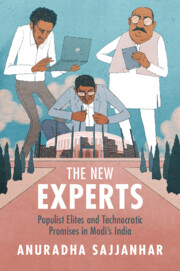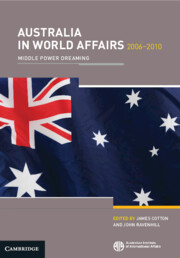1210 results
Academia, Activism, and Popular Consciousness: A Response to Freedom Inc.
-
- Journal:
- Cambridge Journal of Postcolonial Literary Inquiry , First View
- Published online by Cambridge University Press:
- 03 July 2024, pp. 1-10
-
- Article
-
- You have access
- Open access
- HTML
- Export citation
7 - The Affluence–Technology Connection in the Struggle for Sustainability
- from Part II - Critical Engagement of and with Environmental Violence
-
-
- Book:
- Exploring Environmental Violence
- Print publication:
- 30 June 2024, pp 156-181
-
- Chapter
-
- You have access
- Open access
- HTML
- Export citation
Chapter 8 - Steam and Iron in the 1830s
-
-
- Book:
- Nineteenth-Century Literature in Transition: The 1830s
- Published online:
- 30 May 2024
- Print publication:
- 06 June 2024, pp 170-190
-
- Chapter
- Export citation
A Dynamic Theory of Prosecutorial Roles in Adversarial Trials
-
- Journal:
- Asian Journal of Law and Society , First View
- Published online by Cambridge University Press:
- 03 June 2024, pp. 1-26
-
- Article
-
- You have access
- Open access
- HTML
- Export citation
2 - Law as Text
-
-
- Book:
- The Cambridge Comparative History of Ancient Law
- Published online:
- 09 May 2024
- Print publication:
- 30 May 2024, pp 20-72
-
- Chapter
- Export citation
Wafer-Thin History: India and World War I Through Postcards
-
- Journal:
- Critical Pakistan Studies ,
- Published online by Cambridge University Press:
- 20 May 2024, pp. 1-29
-
- Article
-
- You have access
- Open access
- HTML
- Export citation
Princely prisons, state exhibitions, and Muslim industrial authority in colonial India
-
- Journal:
- Journal of the Royal Asiatic Society , First View
- Published online by Cambridge University Press:
- 17 May 2024, pp. 1-22
-
- Article
- Export citation
4 - Sexuality in Traditional South Asian Systems of Thought and Belief
-
-
- Book:
- The Cambridge World History of Sexualities
- Published online:
- 26 April 2024
- Print publication:
- 16 May 2024, pp 63-86
-
- Chapter
- Export citation
11 - Sexuality in Buddhist Traditions
-
-
- Book:
- The Cambridge World History of Sexualities
- Published online:
- 26 April 2024
- Print publication:
- 16 May 2024, pp 228-249
-
- Chapter
- Export citation
19 - Sex in Bombay in the Late Nineteenth and Early Twentieth Centuries
-
-
- Book:
- The Cambridge World History of Sexualities
- Published online:
- 26 April 2024
- Print publication:
- 16 May 2024, pp 402-418
-
- Chapter
- Export citation
Expanding Freedom: A Response
-
- Journal:
- Cambridge Journal of Postcolonial Literary Inquiry , First View
- Published online by Cambridge University Press:
- 16 May 2024, pp. 1-13
-
- Article
-
- You have access
- Open access
- HTML
- Export citation
1 - Introduction
-
- Book:
- The New Experts
- Published online:
- 09 May 2024
- Print publication:
- 16 May 2024, pp 1-16
-
- Chapter
- Export citation
4 - Outsourcing Democracy through Professional Consulting
-
- Book:
- The New Experts
- Published online:
- 09 May 2024
- Print publication:
- 16 May 2024, pp 94-132
-
- Chapter
- Export citation
5 - The Double-Sidedness of Hindutva
-
- Book:
- The New Experts
- Published online:
- 09 May 2024
- Print publication:
- 16 May 2024, pp 133-161
-
- Chapter
- Export citation

The New Experts
- Populist Elites and Technocratic Promises in Modi's India
-
- Published online:
- 09 May 2024
- Print publication:
- 16 May 2024
First photographic record of the snow leopard Panthera uncia in Kishtwar High Altitude National Park, Jammu and Kashmir, India
-
- Journal:
- Oryx , First View
- Published online by Cambridge University Press:
- 09 May 2024, pp. 1-5
-
- Article
-
- You have access
- Open access
- HTML
- Export citation
Intake of free sugars by 11–13-year-old schoolchildren living in Delhi, India
-
- Journal:
- Proceedings of the Nutrition Society / Volume 83 / Issue OCE1 / April 2024
- Published online by Cambridge University Press:
- 07 May 2024, E153
-
- Article
-
- You have access
- Export citation
Intake of energy and macronutrients in the diets of 11–13-year-old schoolchildren living in Delhi India
-
- Journal:
- Proceedings of the Nutrition Society / Volume 83 / Issue OCE1 / April 2024
- Published online by Cambridge University Press:
- 07 May 2024, E145
-
- Article
-
- You have access
- Export citation

Australia in World Affairs 2006–2010
- Middle Power Dreaming
-
- Published online:
- 04 May 2024
Diasporic geopolitics, rising powers, and the future of international order
-
- Journal:
- Review of International Studies / Volume 50 / Issue 3 / May 2024
- Published online by Cambridge University Press:
- 06 May 2024, pp. 476-493
- Print publication:
- May 2024
-
- Article
-
- You have access
- Open access
- HTML
- Export citation



